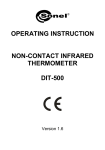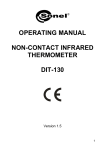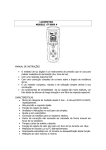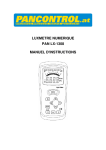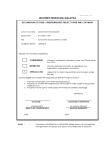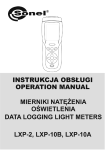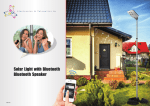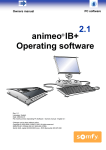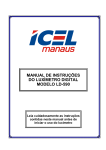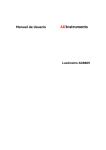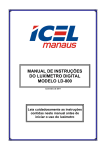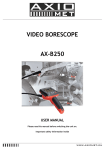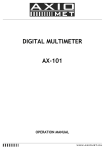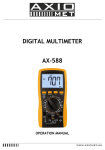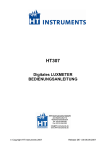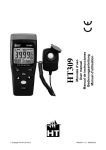Download User Manuals
Transcript
OPERATING INSTRUCTION DATALOGGING LIGHT METER LXP-1 Version 1.7 1 The digital illuminance meter is a precision instrument used to measure illuminance (Lux, footcandle) in the field. It is meet CIE photopic spectral response. It is fully cosine corrected for the angular incidence of light. The illuminance meter is compact, tough and easy to handle owing to its construction. The light sensitive component used in the meter is a very stable, long-life silicon photo diode and spectral response filter. Main features of the LXP-1 device are the following: • • • • • • • • • • • • • • • • • 2 Light-measuring levels ranging from 0,1Lux…0,1kLux (0,01FC…0,01kFC). High accuracy and rapid response. Data-hold function for holding measuring values. Unit and sign display for easy reading. Automatic zeroing. Meter corrected for spectral relative efficiency. Correction factor need not be manually calculated for nonstandard light sources. Peak-hold function for tracing the peak signal of light pulse with least duration 10µs and keep it. Capable of selecting measuring mode in Lux or FC scale alternatively. Auto power off (15minutes) or disable AUTO power off. Maximum and minimum measurements. Relative reading. Easy to read large backlit display USB output connect with PC. 4 Level ranking. 99 values in memory that could be read on the meter and PC. 16000 values records datalogger. 1 FUNCTIONAL DESCRIPTION............................ 4 DEVICES DESCRIPTION ......................................... 4 LCD SYMBOLS ..................................................... 5 2 MEASUREMENT OPERATION .......................... 6 3 FUNCTIONAL DESIGN........................................ 7 3.1 DATA-HOLD MODE .............................................. 7 3.2 PEAK-HOLD MODE ............................................... 7 3.3 MAXIMUM AND MINIMUM MODE ......................... 7 3.4 RELATIVE READING MODE ................................... 7 3.5 USB MODE........................................................... 7 3.6 BACK-LIGHT FUNCTION ....................................... 7 3.7 SETUP TIME AND SAMPLING RATE ........................ 8 3.8 MEM FUNCTION .................................................. 8 3.9 DATALOGGER FUNCTION ................................ 8 3.10 APO (AUTO POWER OFF) FUNCTION ................... 9 4 SPECTRAL SENSITIVITY CHARACTERISTIC .............................................. 9 5 RECOMMENDED ILLUMINATION ................ 10 6 CONNECTING TO PC ........................................ 11 6.1 CONNECTION ..................................................... 11 6.2 INSTALLING THE SOFTWARE .............................. 11 7 BATTERY CHECK-UP & REPLACEMENT ... 12 8 MAINTENANCE .................................................. 12 9 STORAGE ............................................................. 13 10 DISMANTLING AND UTILIZATION .............. 13 11 TECHNICAL DATA ............................................ 13 12 STANDARD EQUIPMENT ................................. 15 13 OPTIONAL EQUIPMENT .................................. 15 14 MANUFACTURER .............................................. 15 1.1 3.1 3 1 Functional description 1.1 Devices description ① Power Control key: The power switch key turns the illuminance meter ON or OFF. ② LCD Display: 3-3/4 digit displays with a maximum reading of 3999, and the indicating signs of measured values, unit function symbols and decimal points etc are display. 4 ③ UNITS key: Pressing this key selects taking measurement of illuminance in Lux or FC scale (1FC =10,76 LUX). ④ BACK-LIGHT and LOAD control key: Back light control and load the records. ⑤ REC and SETUP key: memory the values or set the time, the sampling rate, and Enable the AUTO power off or ont. ⑥ Peak Hold key: Peak Hold recorder control key. ⑦ Data-Hold key: Data Hold control key. ⑧ RANGE key: change the range. 400,0lux ->4000lux ->40,000lux ->400,000lux (40.00FC ->400,0FC ->4000FC ->40,000FC). ⑨ MAX/MIN key: Maximum and minimum reading recorder control key. ⑩ REL key: Relative reading control key. 3.1 LCD symbols ① Main display of light intensity. 5 ② ③ ④ ⑤ ⑥ ⑦ ⑧ ⑨ ⑩ ⑪ ⑫ ⑬ ⑭ ⑮ ⑯ Bargraph. Real time clock, display used to set date and sample rate. Set mode symbols: year, day, time and sample rate. Set mode. Sample rate symbol. PC connection (with Scout symbol). Memory display. Auto off active. Low bartery symbol. Manual mode. Data hold. MIN or MAX (also for Peak Hold function). Ranges of light intensity. Footcandle symbol. Lux symbol. 2 Measurement operation • • • • • • • 6 Power-up: Press the power key to turn the meter ON or OFF. Selecting the Lux or FC scale: Set the range selection switch to desired Lux or FC range. Remove the photo detector cap and face it light source in a horizontal position. Press the REC/SETUP key and RANGE/APO key, Enable the AUTO power off or Disable this function. Read the illuminance nominal from the LCD display. Over range: If the instrument only displays “OL”, the input signal is too strong, and a higher range should be selected. The range will show on the down of the LCD, LUX: 400 -> 4K -> 40k -> 400k; FC: 40 -> 400-> 4k -> 40k. When the measurement is completed, replace the photo detector cap and turn the meter off. 3 Functional design 3.1 • • Press the hold key to select Data-Hold mode. When HOLD mode is selected, the illuminance meter stops all further measurements. Press the HOLD key again to exit Data-Hold mode. Then it resumes normal operation. 3.2 • • • • USB mode Connect with PC with USB, the “ screen. 3.6 • Relative reading mode Press REL key to enter Relative mode. The display shown zero value and the current reading will be stored as a zero-in value. Press again to exit this mode. 3.5 • Maximum and Minimum mode Press MAX/MIN key to choose the Maximum (MAX) reading, Minimum (MIN) reading and current reading (MAX/MIN blink) recorder mode. Press MAX/MIN key again to exit this mode. 3.4 • Peak-Hold mode Press the PEAK key to choose Pmax or Pmin recorder mode, and expose the photo detector to light pulse measuring field. Press the PEAK key again to exit PEAK recorder mode, then the meter will resume normal operation. 3.3 • Data-Hold mode ” will displays in the Back-light function Press shortly the Backlight key to turn on. 7 • Press again to turn off. 3.7 • • • • • • • Press the REC/SETUP and UNITS key start to setup the time and sampling. The first setup target is: The hour Press key ”PEAK or REL“ to choose the object of the setting Press “REL” key to choose object to repeat as below process: hour ->minter ->second ->sampling- >month ->day ->day of the week ->year ->hour … Press PEAK key to choose the object and repeat as below process: Hour ->year ->day of the week ->day ->month >sampling ->second ->minter ->hour ->year … Press MAX/MIN key to add object of setting Press HOLD key to reduce the object of setting Hold key of REC/SETUP and UNITS to exit the setting time and sampling mode, and then confirm. 3.8 • • • • • • • • • 8 MEM function Press key of REC/SETUP to save the present data. HOLD key of LOAD 5s start to load the records Press key of MAX/MIN to add the number of records. Press key of HOLD to reduce the number of records. After you do that you must hold the key of LOAD 5s to resume normal operation. HOLD the key of REC/SETUP and LOAD 5s to clear the 99 memory. 3.9 • Setup time and sampling rate DATALOGGER function SETUP the time and sampling rate first, the default sampling rate is 1s. Hold the key of REC/SETUP 5s, start the datalogger function, the MEM on the screen will be bicker. If the memory IC is full, the memory number will show ‘OL’. The meter logging measured values in chosen sampling rate. Saved data can be read only by using PC software. • • Press the key of REC/SETUP 5s, stop the datalogger function, then the meter will resume normal operation. you could start your records again. To clear the 99 memory: hold REC/SETUP key and PRESS the power key to turn ON the meter, the display will show "dEL". 3.10 APO (Auto Power Off) function • • • After turning on the meter the APO function is active, Press the REC/SETUP and RANGE/APO buttons to disable the feature, Press the buttons combination again to enable the feature. 4 Spectral sensitivity characteristic To the detector, the applied photo diode with filters makes the spectral sensitivity characteristic is well suited to the requirements of the C.I.E. curve (INTERNATIONAL COMMISSION ON ILLUMINATION). Photo curve V (λ) as the following chart described. Fig. 1 Spectral sensitivity characteristic. 9 5 Recommended illumination LOCATIONS Conference, Reception room Clerical work Typing drafting FACTORY Visual work at production line Inspection work Electronic parts assembly line Packing work, Entrance passage HOTEL Public room, Cloakroom Reception Cashier STORE Indoors Stairs Corridor Show window, Packing table Forefront of show window HOSPITAL Sickroom, Warehouse Medical Examination Room Operating room, emergency treatment SCHOOL Auditorium, Indoor Gymnasium Class room Laboratory, Library, Drafting, room OFFICE 1FC=10,76Lux 10 Lux 200~750 FC 18~70 700~1,500 1,000~2,000 300~750 65~140 93~186 28~70 750~1,500 1,500~3,000 70~140 140~279 150~300 14~28 100~200 9~18 200~500 750~1,000 150~200 18~47 70~93 14~18 750~1,500 70~140 1,500~3,000 140~279 100~200 300~750 9~18 28~70 750~1,500 70~140 100~300 9~28 200~750 500~1,500 18~70 47~140 6 Connecting to PC System requirements: Windows 2000, XP or Vista Minimum hardware requirements Pc or notebook, 90MHz Pentium of faster, 32Mb Ram, At least 5Mb free hard disk space screen resolution 800×600. 6.1 • • • • • Switch the light meter on. Plug the other end of the connecting cable to serial interface of the PC (USB). Plug the USB line connecting cable 13,6mm jack plug into the meter socket. Start the light meter software. Selecting the COM. (Note: You should better switch the light meter on before you plug the USB line connecting cable 13,6mm jack plug into the meter). 6.2 • • • • • • • • Connection Installing the software Insert the CD into the CD-drive. Installation should start automaticaly. If not, run the SETUP.EXE from CD. Now follow the installation program instructions. Once the software is installed, switch on the meter. Start the software. Selected the COM port. If the connection is in order, the following display will be seen on the screen in the program. 11 Fig. 2 Display in the program. • If the connection is not in order, the message “OFFLINE” or “NO CONNECTION” appears on the screen. 7 Battery check-up & replacement Attention: When making measurements with a battery's mnemonic on, one must take into account additional indefinite measurement uncertainty or unstable working of the meter. • • • As the battery power is not sufficient, LCD will display low battery, and replacement of one new battery is required. After turning off the meter, open the battery cover. Disconnect the battery from the instrument and replace it with a standard 9V battery and go for the cover. 8 Maintenance • 12 The white plastic disc on the top of the detector should be cleaned with a damp cloth when necessary. • • • Do not store the instrument where temperature or humidity is excessively high. The reference level, as marker on the face plate, is the tip of the photo detector globe. The calibration interval for the photo detector will vary according to operational conditions, but generally the sensitivity decreases in direct proportion to the product of luminous intensity by the operational time. In order to maintain the basic accuracy of the instrument, periodic calibration is recommended. 9 Storage In the case of storage of the recommendations must be observed: • • device, the following Make sure the meter and its accessories are dry. In the case the meter is to be stored for a prolonged period of time, the batteries must be removed from the device. 10 Dismantling and utilization Worn-out electric and electronic equipment should be gathered selectively, i.e. it must not be placed with waste of another kind. Worn-out electronic equipment should be sent to a collection point in accordance with the law of worn-out electric and electronic equipment. Before the equipment is sent to a collection point, do not dismantle any elements. Observe the local regulations concerning disposal of packages, worn-out batteries and accumulators. 11 Technical data “m.v.” means measured value of standard “f.s.” means full scale Measuring Spectral Basic accuracy Range accuracy 400,0 Lx CIE Vλ ±(3% m.v. ± 0.5% f.s.) 40,00 FC Function (<10,000Lx) 13 4000 Lx 400,0 FC 40,00 KLx 4000 FC 400,0 KLx 40,00 KFC f1’ ±6% ±(4% m.v. + 10dig) (>10,000Lx) NOTE: 1FC=10,76Lx;1KLx=1000Lx;1KFC=1000FC • • Over range display: LCD will show “OL” symbol. Spectral response: CIE Photopic. (CIE human eye response curve). Datalogger sampling could be setup. Other technical data: a) photo detector...........…one silicon photo diode and spectral response filter. b) operating temperature & humidity...0℃ to 40℃ (32℉to 104℉) & 0% to 80% RH. c) storage temperature & humidity.-10℃ to 50℃ (14℉ to 140℉) & 0% to 70% RH. d) display...…..…..3-3/4 digit LCD with high speed 40 segment bar graph e) repeatability...……………………………………………………±3% f) cosine response..……….:……………………………….….f2’ ±2% g) sampling rate…………….1,3 times/sec of analog bar-graph indication and LCD h) memory……………………………………………………….99 cells i) logger………………………………………….…….16000 samples j) power supply.….………………………….……..1 piece 9V battery k) photo detector lead length.…..……….………….150cm (approx.) l) photo detector dimensions.……………….115L×60W×20H (mm) m) meter dimensions.………………………….170L×80W×40H (mm) n) weight..……………………………………………….………….390g 14 12 Standard equipment The standard set provided by the manufacturer includes the following components: • The LXP-1 meter, • 9V bartery, • data CD with “Light Meter” software, • USB cable, • Operating manual, • Carrying case, • Warranty card. 13 Optional equipment Additional accessories that are not a part of the standard kit can be purchased from the manufacturer or from suppliers: • light measurements software Foton 12464 generating measurement protocols. 14 Manufacturer The manufacturer of the device, which also provides guarantee and post-guarantee service is the following company: SONEL S. A. ul. Wokulskiego 11 58-100 Świdnica Tel: +48 74 858 38 60 Fax: +48 74 858 38 09 E-mail: [email protected] Web page: www.sonel.pl Service repairs manufacturer. must Note: be realised solely by the Made in China for SONEL S.A. 15 16

















